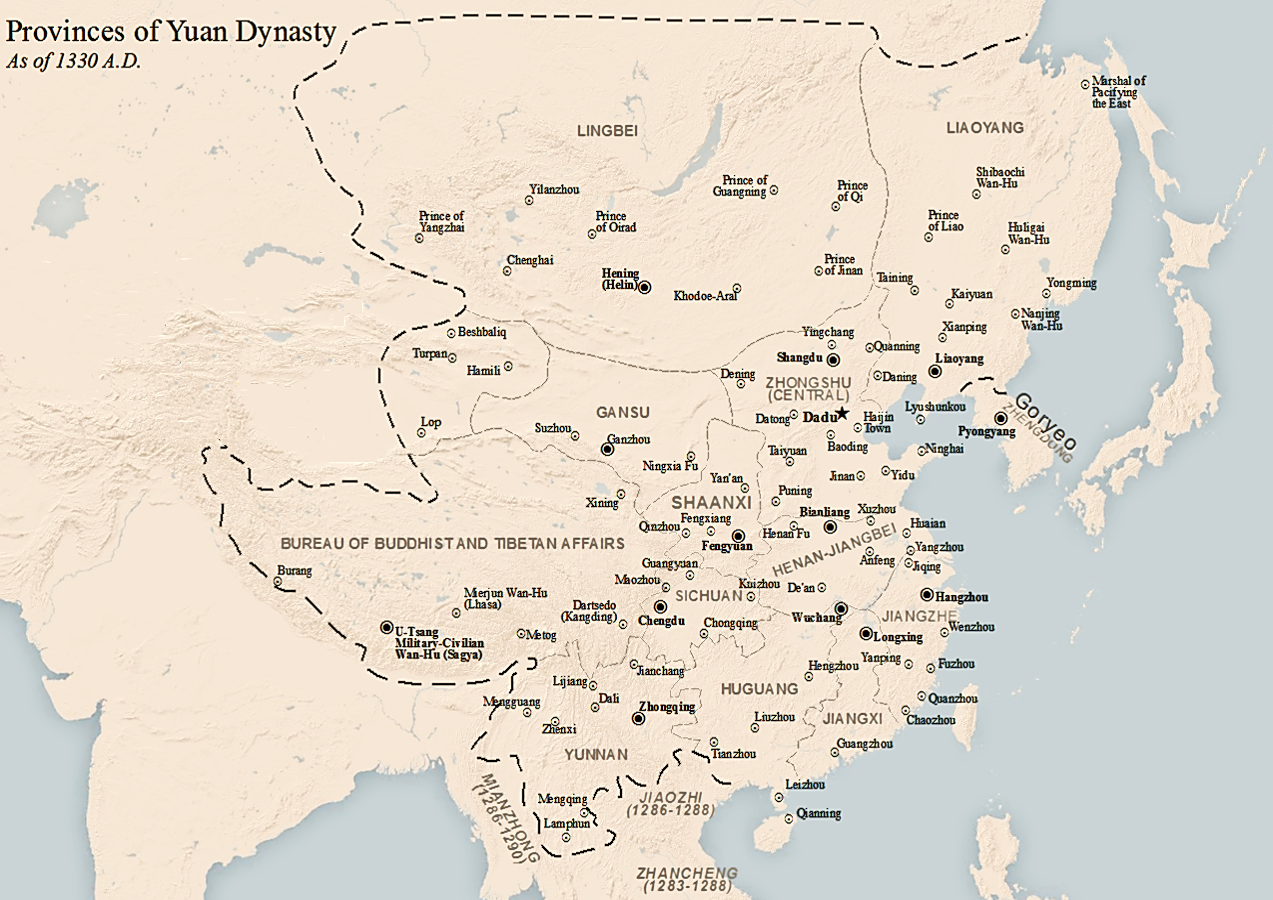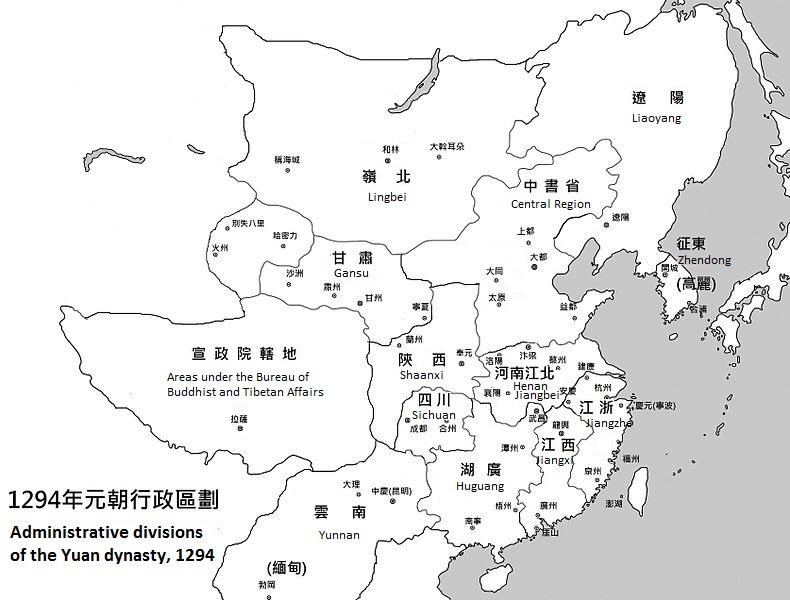|
Jiangxi Province (Yuan Dynasty)
Jiangxi province was a province of the Yuan dynasty established in 1277. It included modern Jiangxi, and most of Guangdong.Duosang Mongol History, Vol. 1; Zhong-gou Tong-shi; History of Zhong-gou Border Nationalities; The New Yuan-shih The capital was Longxing (now called Nanchang). See also * Administrative divisions of the Yuan dynasty The Yuan dynasty was a Mongol-led imperial Chinese dynasty. During its existence, its territory was divided into the Central Region (θ Ήθ£) governed by the Central Secretariat (Zhongshu Sheng) and places under control of various provinces (θ‘ ... References {{coord missing, China Provinces of the Yuan dynasty 1277 establishments History of Jiangxi History of Guangdong ... [...More Info...] [...Related Items...] OR: [Wikipedia] [Google] [Baidu] |
Yuan Provinces
Yuan may refer to: Currency * Yuan (currency), the basic unit of currency in historic and contemporary mainland China and Taiwan **Renminbi, the current currency used in mainland China, whose basic unit is yuan ** New Taiwan dollar, the current currency used in Taiwan, whose basic unit is yuΓ‘n in Mandarin ** Manchukuo yuan, the unit of currency that was used in the Japanese puppet state of Manchukuo Governmental organ * "Government branch" or "Court" (), the Chinese name for a kind of executive institution. Government of Taiwan * Control Yuan * Examination Yuan * Executive Yuan * Judicial Yuan * Legislative Yuan Government of Imperial China * Xuanzheng Yuan, or Bureau of Buddhist and Tibetan Affairs during the Yuan dynasty * Lifan Yuan during the Qing dynasty Dynasties * Yuan dynasty (ε ζ), a dynasty of China ruled by the Mongol Borjigin clan ** Northern Yuan dynasty (εε ), the Yuan dynasty's successor state in northern China and the Mongolian Plateau People and languag ... [...More Info...] [...Related Items...] OR: [Wikipedia] [Google] [Baidu] |
Yuan Dynasty
The Yuan dynasty (), officially the Great Yuan (; xng, , , literally "Great Yuan State"), was a Mongol-led imperial dynasty of China and a successor state to the Mongol Empire after its division. It was established by Kublai, the fifth khagan-emperor of the Mongol Empire from the Borjigin clan, and lasted from 1271 to 1368. In orthodox Chinese historiography, the Yuan dynasty followed the Song dynasty and preceded the Ming dynasty. Although Genghis Khan had been enthroned with the Han-style title of Emperor in 1206 and the Mongol Empire had ruled territories including modern-day northern China for decades, it was not until 1271 that Kublai Khan officially proclaimed the dynasty in the traditional Han style, and the conquest was not complete until 1279 when the Southern Song dynasty was defeated in the Battle of Yamen. His realm was, by this point, isolated from the other Mongol-led khanates and controlled most of modern-day China and its surrounding areas, including ... [...More Info...] [...Related Items...] OR: [Wikipedia] [Google] [Baidu] |
Jiangxi
Jiangxi (; ; formerly romanized as Kiangsi or Chianghsi) is a landlocked province in the east of the People's Republic of China. Its major cities include Nanchang and Jiujiang. Spanning from the banks of the Yangtze river in the north into hillier areas in the south and east, it shares a border with Anhui to the north, Zhejiang to the northeast, Fujian to the east, Guangdong to the south, Hunan to the west, and Hubei to the northwest. The name "Jiangxi" is derived from the circuit administrated under the Tang dynasty in 733, Jiangnanxidao (; Gan: Kongnomsitau). The abbreviation for Jiangxi is "" (; Gan: GΕm), for the Gan River which runs across from the south to the north and flows into the Yangtze River. Jiangxi is also alternately called ''Ganpo Dadi'' () which literally means the "Great Land of Gan and Po". After the fall of the Qing dynasty, Jiangxi became one of the earliest bases for the Communists and many peasants were recruited to join the growing people's ... [...More Info...] [...Related Items...] OR: [Wikipedia] [Google] [Baidu] |
Guangdong
Guangdong (, ), alternatively romanized as Canton or Kwangtung, is a coastal province in South China on the north shore of the South China Sea. The capital of the province is Guangzhou. With a population of 126.01 million (as of 2020) across a total area of about , Guangdong is the most populous province of China and the 15th-largest by area as well as the second-most populous country subdivision in the world (after Uttar Pradesh in India). Its economy is larger than that of any other province in the nation and the fifth largest sub-national economy in the world with a GDP (nominal) of 1.95 trillion USD (12.4 trillion CNY) in 2021. The Pearl River Delta Economic Zone, a Chinese megalopolis, is a core for high technology, manufacturing and foreign trade. Located in this zone are two of the four top Chinese cities and the top two Chinese prefecture-level cities by GDP; Guangzhou, the capital of the province, and Shenzhen, the first special economic zone in the count ... [...More Info...] [...Related Items...] OR: [Wikipedia] [Google] [Baidu] |
Nanchang
Nanchang (, ; ) is the capital of Jiangxi Province, People's Republic of China. Located in the north-central part of the province and in the hinterland of Poyang Lake Plain, it is bounded on the west by the Jiuling Mountains, and on the east by Poyang Lake. Because of its strategic location connecting the prosperous East and South China, it has become a major railway hub in Southern China in recent decades. As the Nanchang Uprising in 1927 is distinctively recognized by the ruling Communist Party as "firing the first gunshot against the evil Nationalists", the current government has therefore named the city since 1949 "the City of Heroes", "the place where the People's Liberation Army was born", and the most widely known "place where the military banner of the People's Liberation Army was first raised". Nanchang is also a major city, appearing among the top 150 cities in the world by scientific research outputs, as tracked by the Nature Index and home to Nanchang Universit ... [...More Info...] [...Related Items...] OR: [Wikipedia] [Google] [Baidu] |
Administrative Divisions Of The Yuan Dynasty
The Yuan dynasty was a Mongol-led imperial Chinese dynasty. During its existence, its territory was divided into the Central Region (θ Ήθ£) governed by the Central Secretariat (Zhongshu Sheng) and places under control of various provinces (θ‘η) or Branch Secretariats (θ‘δΈζΈη), as well as the region under the Bureau of Buddhist and Tibetan Affairs (Xuanzheng Yuan). In addition, the Yuan emperors held nominal suzerainty over the western Mongol khanates, but in reality none of them were governed by the Yuan dynasty due to the division of the Mongol Empire. Overview The most important part of the Yuan Empire was the Central Region, which covered the region of the Yuan capital Khanbaliq (Dadu, modern Beijing). The Central Region consisted of present-day Hebei, Shandong, Shanxi, the south-eastern part of present-day Inner Mongolia and the Henan areas to the north of the Yellow River. Since it was considered the most important region of the dynasty, it was directly governe ... [...More Info...] [...Related Items...] OR: [Wikipedia] [Google] [Baidu] |
Provinces Of The Yuan Dynasty
A province is almost always an administrative division within a country or sovereign state, state. The term derives from the ancient Roman ''Roman province, provincia'', which was the major territorial and administrative unit of the Roman Empire, Roman Empire's territorial possessions outside Roman Italy, Italy. The term ''province'' has since been adopted by many countries. In some countries with no actual provinces, "the provinces" is a metaphorical term meaning "outside the capital city". While some provinces were produced artificially by Colonialism, colonial powers, others were formed around local groups with their own ethnic identities. Many have their own powers independent of central or Federation, federal authority, especially Provinces of Canada, in Canada and Pakistan. In other countries, like Provinces of China, China or Administrative divisions of France, France, provinces are the creation of central government, with very little autonomy. Etymology The English langu ... [...More Info...] [...Related Items...] OR: [Wikipedia] [Google] [Baidu] |
1277 Establishments
1 (one, unit, unity) is a number representing a single or the only entity. 1 is also a numerical digit and represents a single unit of counting or measurement. For example, a line segment of ''unit length'' is a line segment of length 1. In conventions of sign where zero is considered neither positive nor negative, 1 is the first and smallest positive integer. It is also sometimes considered the first of the infinite sequence of natural numbers, followed by 2, although by other definitions 1 is the second natural number, following 0. The fundamental mathematical property of 1 is to be a multiplicative identity, meaning that any number multiplied by 1 equals the same number. Most if not all properties of 1 can be deduced from this. In advanced mathematics, a multiplicative identity is often denoted 1, even if it is not a number. 1 is by convention not considered a prime number; this was not universally accepted until the mid-20th century. Additionally, 1 is the s ... [...More Info...] [...Related Items...] OR: [Wikipedia] [Google] [Baidu] |







